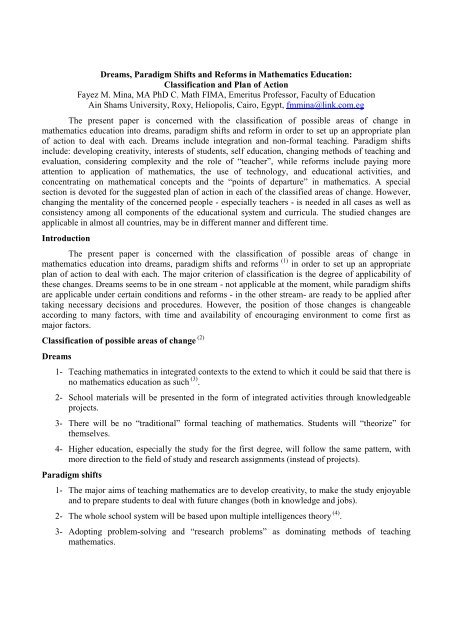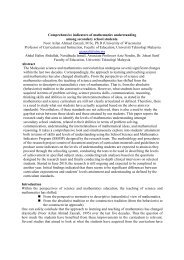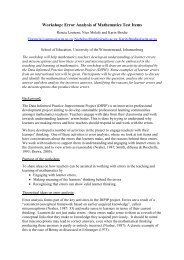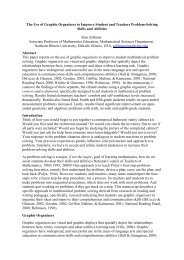Dreams, Paradigm Shifts and Reforms in Mathematics Education ...
Dreams, Paradigm Shifts and Reforms in Mathematics Education ...
Dreams, Paradigm Shifts and Reforms in Mathematics Education ...
You also want an ePaper? Increase the reach of your titles
YUMPU automatically turns print PDFs into web optimized ePapers that Google loves.
<strong>Dreams</strong>, <strong>Paradigm</strong> <strong>Shifts</strong> <strong>and</strong> <strong>Reforms</strong> <strong>in</strong> <strong>Mathematics</strong> <strong>Education</strong>:Classification <strong>and</strong> Plan of ActionFayez M. M<strong>in</strong>a, MA PhD C. Math FIMA, Emeritus Professor, Faculty of <strong>Education</strong>A<strong>in</strong> Shams University, Roxy, Heliopolis, Cairo, Egypt, fmm<strong>in</strong>a@l<strong>in</strong>k.com.egThe present paper is concerned with the classification of possible areas of change <strong>in</strong>mathematics education <strong>in</strong>to dreams, paradigm shifts <strong>and</strong> reform <strong>in</strong> order to set up an appropriate planof action to deal with each. <strong>Dreams</strong> <strong>in</strong>clude <strong>in</strong>tegration <strong>and</strong> non-formal teach<strong>in</strong>g. <strong>Paradigm</strong> shifts<strong>in</strong>clude: develop<strong>in</strong>g creativity, <strong>in</strong>terests of students, self education, chang<strong>in</strong>g methods of teach<strong>in</strong>g <strong>and</strong>evaluation, consider<strong>in</strong>g complexity <strong>and</strong> the role of “teacher”, while reforms <strong>in</strong>clude pay<strong>in</strong>g moreattention to application of mathematics, the use of technology, <strong>and</strong> educational activities, <strong>and</strong>concentrat<strong>in</strong>g on mathematical concepts <strong>and</strong> the “po<strong>in</strong>ts of departure” <strong>in</strong> mathematics. A specialsection is devoted for the suggested plan of action <strong>in</strong> each of the classified areas of change. However,chang<strong>in</strong>g the mentality of the concerned people - especially teachers - is needed <strong>in</strong> all cases as well asconsistency among all components of the educational system <strong>and</strong> curricula. The studied changes areapplicable <strong>in</strong> almost all countries, may be <strong>in</strong> different manner <strong>and</strong> different time.IntroductionThe present paper is concerned with the classification of possible areas of change <strong>in</strong>mathematics education <strong>in</strong>to dreams, paradigm shifts <strong>and</strong> reforms (1) <strong>in</strong> order to set up an appropriateplan of action to deal with each. The major criterion of classification is the degree of applicability ofthese changes. <strong>Dreams</strong> seems to be <strong>in</strong> one stream - not applicable at the moment, while paradigm shiftsare applicable under certa<strong>in</strong> conditions <strong>and</strong> reforms - <strong>in</strong> the other stream- are ready to be applied aftertak<strong>in</strong>g necessary decisions <strong>and</strong> procedures. However, the position of those changes is changeableaccord<strong>in</strong>g to many factors, with time <strong>and</strong> availability of encourag<strong>in</strong>g environment to come first asmajor factors.Classification of possible areas of change (2)<strong>Dreams</strong>1- Teach<strong>in</strong>g mathematics <strong>in</strong> <strong>in</strong>tegrated contexts to the extend to which it could be said that there isno mathematics education as such (3) .2- School materials will be presented <strong>in</strong> the form of <strong>in</strong>tegrated activities through knowledgeableprojects.3- There will be no “traditional” formal teach<strong>in</strong>g of mathematics. Students will “theorize” forthemselves.4- Higher education, especially the study for the first degree, will follow the same pattern, withmore direction to the field of study <strong>and</strong> research assignments (<strong>in</strong>stead of projects).<strong>Paradigm</strong> shifts1- The major aims of teach<strong>in</strong>g mathematics are to develop creativity, to make the study enjoyable<strong>and</strong> to prepare students to deal with future changes (both <strong>in</strong> knowledge <strong>and</strong> jobs).2- The whole school system will be based upon multiple <strong>in</strong>telligences theory (4) .3- Adopt<strong>in</strong>g problem-solv<strong>in</strong>g <strong>and</strong> “research problems” as dom<strong>in</strong>at<strong>in</strong>g methods of teach<strong>in</strong>gmathematics.
4- Complexity is considered <strong>in</strong> all educational activities (5) . Emphasis must be given to “commons”among different systems to state assumptions underly<strong>in</strong>g different formulas <strong>and</strong> the existence ofdifferent possible solutions.5- Evaluation of students is ma<strong>in</strong>ly based on cont<strong>in</strong>uous <strong>and</strong> non-formal evaluation. Greatattention will be given to self evaluation <strong>and</strong> discussion of student’s reports <strong>and</strong> “researchwork”.6- The major job of a teacher is as facilitator.<strong>Reforms</strong>1- Study<strong>in</strong>g applications of mathematics <strong>in</strong> other discipl<strong>in</strong>es <strong>and</strong> <strong>in</strong> life, as an essential part ofschool mathematics.2- Concentrat<strong>in</strong>g on conceptual bases with very little attention to computations, with the use ofcalculators <strong>and</strong> computers.3- Intensive use of technology, with emphasis on data collection, build<strong>in</strong>g knowledge <strong>and</strong> selflearn<strong>in</strong>g.4- Study<strong>in</strong>g the history of mathematics, with particular emphasis on the “departure po<strong>in</strong>ts” (thecultural historical approach).5- Pay<strong>in</strong>g more attention to school activities relevant to mathematics education.Suggested plan of action1- Start<strong>in</strong>g with reforms <strong>and</strong> attempt<strong>in</strong>g some “paradigm shifts”.2- As for reforms:a) Plan to implement reforms, e.g. prepare necessary equipments, conduct<strong>in</strong>g <strong>in</strong>-serviceteacher education programmes, chang<strong>in</strong>g current pre-service teacher educationprogrammes- when needed … etc.b) Study<strong>in</strong>g past experiences <strong>and</strong> consider<strong>in</strong>g lessons from them. For <strong>in</strong>stance, some goodapplications of mathematics are <strong>in</strong>cluded <strong>in</strong> some text books (6) , but ignored by teachers, maybe because they are not <strong>in</strong>cluded <strong>in</strong> exam<strong>in</strong>ations.c) Participation of teachers <strong>in</strong> all procedures lead<strong>in</strong>g to reform.3- As for adopt<strong>in</strong>g paradigm shifts, the follow<strong>in</strong>g procedures can be taken:a) Conv<strong>in</strong>c<strong>in</strong>g teachers <strong>and</strong> the public op<strong>in</strong>ion - <strong>in</strong> general, with the value of these paradigmshifts <strong>and</strong> expla<strong>in</strong><strong>in</strong>g the way to implement them.b) Consistency of all components of the whole educational system as well as those ofmathematics curricula <strong>in</strong>clud<strong>in</strong>g aims, content, methods of teach<strong>in</strong>g, us<strong>in</strong>g technology,educational activities <strong>and</strong> evaluation.c) Priorities for change are for: text-books, teach<strong>in</strong>g methods, means <strong>and</strong> tools of evaluation<strong>and</strong> school activities.4- As regards dreams, many steps can be taken, such as:a) Pav<strong>in</strong>g the way to change the mentality of planners, text-book writers, adm<strong>in</strong>istrators,teachers, parents <strong>and</strong> students for specific changes, particularly <strong>in</strong>tegration.
) Chang<strong>in</strong>g the whole system of both pre-service <strong>and</strong> <strong>in</strong>-service teacher education.A F<strong>in</strong>al Wordc) Encourag<strong>in</strong>g attempts to <strong>in</strong>tegrate branches with<strong>in</strong> a subject <strong>and</strong> among some subjects.The author would like to confirm the follow<strong>in</strong>g:a) The previous classification is flexible <strong>and</strong> some of its items are <strong>in</strong>teracted <strong>and</strong> <strong>in</strong>terrelated.b) Many of these previous elements- especially reforms- are applied <strong>in</strong> some countries.c) The mentioned areas of change are applicable <strong>in</strong> almost all countries, may be <strong>in</strong> differentmanner <strong>and</strong> different time.Notes(1) Although the author can not deal with all the terms <strong>in</strong>volved with<strong>in</strong> the available space, he would like toexpla<strong>in</strong> that he means by paradigm shift “a revolution due to a fundamental change <strong>in</strong> our world viewwhich changes even the way reality is perceived <strong>and</strong> underst<strong>and</strong>”.See: Kuhn, Thomas S. (1972). The Structure of Scientific Revolutions London: Phoenix.Quoted from: Rugerson, Alan (2010). “The DQME Project as Part of a World-Wide <strong>Paradigm</strong> Shift In<strong>Mathematics</strong> <strong>Education</strong>”, A Background Paper Presented to the DQME3 Meet<strong>in</strong>g, June 29 - July 2,2010, Ciechoc<strong>in</strong>ek (Pol<strong>and</strong>).(2) For sources of these areas of change, the writer reviewed his papers which were presented to ME21Conferences (1999, 2000, 2003, 2004 <strong>and</strong> 2005), <strong>in</strong> addition to the follow<strong>in</strong>g paper:M<strong>in</strong>a, Fayez M. (2010). “Some Suggested Alternatives to Activate Some New Trends <strong>in</strong> <strong>Mathematics</strong><strong>Education</strong>”, A Paper Presented to the Conference of the Egyptian Society of <strong>Mathematics</strong> <strong>Education</strong>,Cairo, 3 rd August, 2010. (In Arabic).(3) It seems that the only attempt to <strong>in</strong>tegrate mathematics with life is done by MISP <strong>in</strong> rather primaryeducation. See:Gamble, Andy <strong>and</strong> Rogerson, Alan (1997). Mak<strong>in</strong>g L<strong>in</strong>ks. New Zeal<strong>and</strong>: User Friendly ResourceEnterprises.Rogerson, Alan (1995). Play<strong>in</strong>g Cards, <strong>and</strong> Build<strong>in</strong>g Bridges. (The same publisher).Rogerson, Alan (1998). Div<strong>in</strong>e Designs; <strong>and</strong> Patterns & Til<strong>in</strong>g (The same publisher).Rogerson, Alan (1999). Maths? It’s magic: (The same publisher).(4) See:Gardner, Howard (1983). Frames of M<strong>in</strong>d: The Theory of Multiple Intelligences. New York: BasicBooks.(1999). Intelligence Reframed; Multiple Intelligence for the 21 st Century: NewYork: Basic Books.(5) Complexity can be described <strong>in</strong> terms of the follow<strong>in</strong>g terms:1- There is no more simple <strong>and</strong> absolute laws controll<strong>in</strong>g motion <strong>and</strong> globe.2- Unity of human knowledge.3- Research is no more neutral.4- Thought is no more controlled by logic, <strong>and</strong> knowledge is no more certa<strong>in</strong>.5- It is suggested that the ma<strong>in</strong> goal of science is to underst<strong>and</strong> realty with the <strong>in</strong>tention to<strong>in</strong>fluence <strong>and</strong> change it.6- Cohesion of knowledge <strong>and</strong> its technological applications.7- The development <strong>in</strong> technologies of communication, measurement <strong>and</strong> its units <strong>and</strong> scientificcalculations.See:
M<strong>in</strong>a, Fayez M. (2003). Issues <strong>in</strong> Curricula of <strong>Education</strong>. Cairo the Anglo-EgyptianBookshop, pp. 23 - 26. (In Arabic).(6) For Example: See the series of mathematics text-books MATH POWER TM from 7 th to 12 th Grades,published by McGraw-Hill Ryerson Limited <strong>in</strong> Canada.ReferenceGamble, Andy <strong>and</strong> Rogerson, Alan (1997). Mak<strong>in</strong>g l<strong>in</strong>ks. New Zeal<strong>and</strong>: User Friendly Resource EnterprisesGardner, Howard (1983). Frames of M<strong>in</strong>d: The Theory of Multiple Intelligences. New York: Basic Books.(1999). Intelligence Reframed; Multiple Intelligence for the 21 st Century. New York: BasicBooks.Horton, Gary <strong>and</strong> McBride, Kerry (1998). MATH POWER TM 10 (Western edition). Toronto McGraw-Hill RyersonLimited.Knill, George et al (1996). MATH POWER TM 8, 9 (Western editions). Toronto: McGraw-Hill Ryerson Limited.(1998). MATH POWER TM 11, 12 (Western editions). Toronto: McGraw-Hill Ryerson Limited.M<strong>in</strong>a, Fayez M. (1999). “<strong>Mathematics</strong> <strong>Education</strong> between Theory <strong>and</strong> Practice: Narrow<strong>in</strong>g the Gap: A NecessaryCondition for Reform. In: Alan Rogerson (Ed.), Proceed<strong>in</strong>gs of The International Conference of The <strong>Mathematics</strong><strong>Education</strong> <strong>in</strong>to The 21 st Century Project on “<strong>Mathematics</strong> <strong>Education</strong> <strong>in</strong>to The 21 st Century: Social Challenges,Issues <strong>and</strong> Approaches”, Cairo, November 14-18, 1999. Vol. 1, pp. 241-244.M<strong>in</strong>a, Fayez M. (2000). “Theoriz<strong>in</strong>g for Non-Theoretical Approaches to <strong>Mathematics</strong> <strong>Education</strong>”. In: AlanRogerson (Ed.), Proceed<strong>in</strong>gs of the International Conference of ME21 on “<strong>Mathematics</strong> for Liv<strong>in</strong>g”, Amman,Jordan, November 18-23, 2000, PP. 6-10.(2001). “Prospective Scenarios for <strong>Mathematics</strong> <strong>Education</strong> around the Year 2020”, In: AlanRogerson: Proceed<strong>in</strong>gs of the International Conference of ME on “Now Ideas <strong>in</strong> <strong>Mathematics</strong> <strong>Education</strong>”, PalmCove, Queensl<strong>and</strong>, Australia, August 19-24, 2001, PP 176-179.(2003). Issues <strong>in</strong> Curricula of <strong>Education</strong>. Cairo: The Anglo-Egyptian Bookshop. (In Arabic).(2003). “The Decidable <strong>and</strong> the Undecidable <strong>in</strong> <strong>Mathematics</strong> <strong>Education</strong>”. In: Alan Rogerson (Ed.),Proceed<strong>in</strong>gs of the International Conference of the ME21 on “The Decidable <strong>and</strong> The Undecidable <strong>in</strong><strong>Mathematics</strong> <strong>Education</strong>”, Brno, Czech Republic, September 19-25, 2003, pp. 186-188.(2004). “Some Remarks on the Future of <strong>Mathematics</strong> <strong>Education</strong>”. In: Alan Rogerson (Ed.)Proceed<strong>in</strong>gs of The International Conference of The Me21 on “The Future Of <strong>Mathematics</strong> <strong>Education</strong>”,Ciechoc<strong>in</strong>ek, Pol<strong>and</strong>, 26 June- 1 July, 2004, pp. 93-97.(2005). “Reform, Revolution <strong>and</strong> <strong>Paradigm</strong> <strong>Shifts</strong> <strong>in</strong> <strong>Mathematics</strong> <strong>Education</strong>: Some Examples <strong>and</strong>Applicable strategies”. In: Alan Rogerson (Ed.), Proceed<strong>in</strong>gs of The International Coherence of The ME21 on“Reform, Revolution <strong>and</strong> <strong>Paradigm</strong> <strong>Shifts</strong> <strong>in</strong> <strong>Mathematics</strong> <strong>Education</strong>”, Johar Bharu, Malaysia, 25 November- 1December, 2005, pp. 154-158.(2010). Some Thoughts about <strong>Mathematics</strong> <strong>Education</strong>. A Background Paper Presented atDQME3 Meet<strong>in</strong>g, Ciechoc<strong>in</strong>ek, Pol<strong>and</strong>, June 29 - July 2, 2010.(2010). “Some Suggested Alternatives to Activate some New Trends <strong>in</strong> <strong>Mathematics</strong> <strong>Education</strong>”, APaper Presented to the Conference of the Egyptian Society of <strong>Mathematics</strong> <strong>Education</strong>, Cairo, 3 rd August, 2010. (InArabic).Rogerson, Alan (1995). Play<strong>in</strong>g Cards. New Zeal<strong>and</strong>: User Friendly Resource Enterprises.(1995). Build<strong>in</strong>g Bridges. New Zeal<strong>and</strong>: User Friendly Resource Enterprises.(1998). Div<strong>in</strong>e Designs. New Zeal<strong>and</strong>: User Friendly Resource Enterprises.(1998). Patterns & Til<strong>in</strong>g. New Zeal<strong>and</strong>: User Friendly Resource Enterprises.(1999). Maths? It’s Magic!. New Zeal<strong>and</strong>: User Friendly Resource Enterprises.(2010). “The DQME Project as Part of a World- wide <strong>Paradigm</strong> Shift <strong>in</strong> <strong>Mathematics</strong> <strong>Education</strong>”, ABackground Paper Presented at the DQME3 Meet<strong>in</strong>g, Ciechoc<strong>in</strong>ek, Pol<strong>and</strong>, June 29- July 2, 2010.Stuart, Susan <strong>and</strong> Timoter, Enzo (1996). MATHPOWER TM Seven (Western edition). Toronto: McGraw-HillRayerson Limited.







